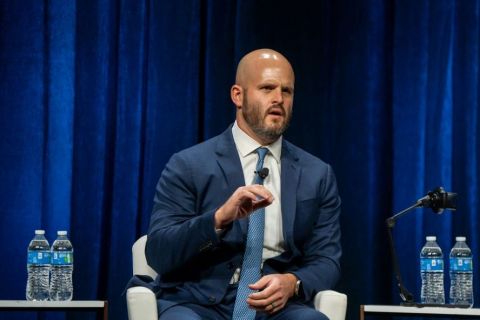
HOUSTON—With overall energy demand expected to continue climbing, deepwater oil and gas will play an ongoing role in the energy mix going forward, according to an industry expert.
Jeff Weidner, vice president of the deepwater portfolio at ExxonMobil Research Co., said new metrics must feature in field development decisions. And when an operator finds “advantaged resources” such as ExxonMobil’s string of deepwater discoveries in Guyana, the key is to bring those reserves onstream as quickly as possible.
That does, however, place a strain on various teams involved in the project as well as the ability to deploy certain technologies. And when it comes to using new technology, its value must meet or exceed the costs, he said during “The Critical Role of Deep Water in the Present and Future Energy Mix” executive dialogue at the Offshore Technology Conference (OTC) on May 4.
Because energy is linked to human development, economic progress and the overall quality of life, “it’s hard to imagine energy demand doing anything but increasing,” Weidner said.
And the expectation is that there will be a “strong need” for oil and gas in the future energy mix. But what the industry currently has on tap won’t be enough to meet projected demand, he said.
“Trillions of dollars are needed over the next 20 years just to meet even those conservative estimates of oil and gas demand,” he said.
When operators make investment decisions, they can no longer consider only factors like potential profitability, materiality and rate of return, he said. They must also consider the carbon intensity of the project over its entire life cycle, he said.
And large deepwater discoveries can check off all those boxes.
“A lot of the industry is focus on the deepwater because it’s recognized that that is where you can make a significant impact and meet those metrics,” Weidner said. “You can get that sweet spot with deepwater. It can provide significant production, and you can usually get it online faster than if you’re trying to build an LNG plant.”
With these things in mind, he said, ExxonMobil is focusing its exploration efforts on deepwater. And that focus has paid off in Guyana, where the supermajor has reported 18 deepwater discoveries since 2015, including three in late April. They achieved first oil on one in 2019 and the second earlier this year.
“This is an advantaged resource,” he said. “We can only cross our fingers and hope for another Guyana.”
One of the things ExxonMobil has also discovered is that it’s vital to bring deepwater discoveries onstream as quickly as possible. For comparison, he cited discoveries made in the 1990s offshore Angola that weren’t brought online until the mid-2000s.
“That’s a bar that the industry is looking at, how do we shorten that timeline?” he asked. “They’re all looking at how can we shorten that timeline from seven years to five years to four years to the unthinkable three years.”
Fast-tracking the Guyana projects has “stressed out our subsurface organization,” he added.
The team only had a certain amount of information on which to design the field development, he said.
“We like to work to a certain level of detail, but what is the level of detail we do need?” Weidner asked.
Enter the need for flexibility in infrastructure that reflects a 20-year or longer investment, he said.
He estimated that countless projects have led to people thinking, “I wish I had a little more capacity or several more well slots, or if I’d only put it here instead of there.”
Building in flexibility can help meet unexpected needs and help that infrastructure remain productive over the entire design life, he said.
Sometimes there is a tradeoff when considering whether to use certain technologies, he said.
For instance, there is a huge desire for data.
“From a reservoir standpoint, the more data I have, the better. Even if I don’t need it, I want it because it’s going to be helpful,” Weidner said.
But in some cases, data can be a hindrance, he said.
He cited smart completions that give control over the well as one example.
“Why wouldn’t I want that on every single well?” he asked.
The answer is that the control comes at a cost, he said.
“There’s a little bit of a bottleneck here and there, and if I put them on all the wells, I won’t have the same high flow rate,” he said. “So you have to step back and look at things and point out the limitations of certain designs.”
That means asking if there’s a better way to achieve the desired outcome and then working with the vendors to make it happen, he said.
Recommended Reading
From Restructuring to Reinvention, Weatherford Upbeat on Upcycle
2024-02-11 - Weatherford CEO Girish Saligram charts course for growth as the company looks to enter the third year of what appears to be a long upcycle.
TechnipFMC Eyes $30B in Subsea Orders by 2025
2024-02-23 - TechnipFMC is capitalizing on an industry shift in spending to offshore projects from land projects.
NOV's AI, Edge Offerings Find Traction—Despite Crowded Field
2024-02-02 - NOV’s CEO Clay Williams is bullish on the company’s digital future, highlighting value-driven adoption of tech by customers.
Patterson-UTI Braces for Activity ‘Pause’ After E&P Consolidations
2024-02-19 - Patterson-UTI saw net income rebound from 2022 and CEO Andy Hendricks says the company is well positioned following a wave of E&P consolidations that may slow activity.
ProPetro Reports Material Weakness in Financial Reporting Controls
2024-03-14 - ProPetro identified a material weakness in internal controls over financial reporting, the oilfield services firm said in a filing.






